In the past few years Google have been refining the way that it displays results to users. In particular, Google has been increasing the number of Featured Snippets that it displays for queries. This actually pushes organic results further down the page. So what does that mean for SEOs?
Well, that's what I set out to explore. Naturally, ranking in the Featured Snippet itself remedies the problem of positioning, but is this strategy something worth doing? What is a Featured Snippet, anyway? And more importantly, what do you have to do to appear there?
What Is a Featured Snippet?
Featured Snippets — also known as answer boxes — are selections of content displayed on the search engine results page (SERP) without the user having to visit the page where the content lives. Google puts these snippets above regular SERP results but below the ads in an effort of serving the user better.
For example, the Featured Snippet below displays the direct instructions pulled from the tasteofhome.com web page.
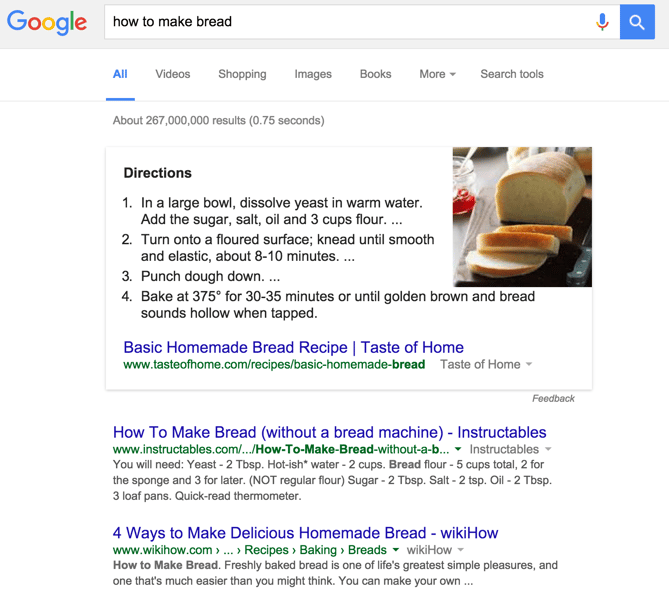
There are no ads for this query, so the Featured Snippet shown in the answer box is above position 1 of the SERPs for "how to make bread." The directions are shown in four steps before the user has to click a single link.
Types of Featured Snippet
- Paragraph
- List
- Table
- Video
- Accordion
- Rich Answer
- Tool or Calculator
Paragraph
Paragraph-formatted answer to the searcher's query. This is the most common type of Featured Snippet, encompassing 50% of all snippet results (Moz 2019).

List
Bulleted or numbered list that answers the searcher's query (typically shows up for more process-driven, step-by-step, and list queries). This is the next most common type of Featured Snippet, encompassing 37% of snippet results (Moz).
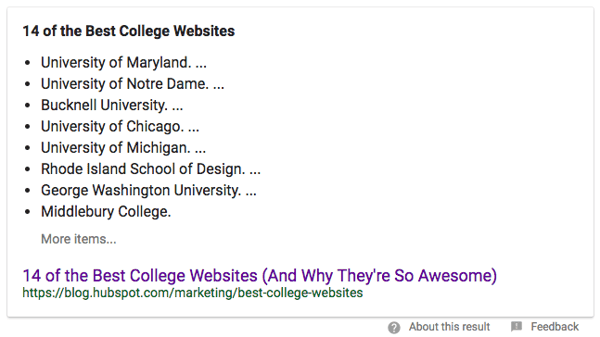
List snippets can take the form of numbered or bulleted lists.
Table
Answer to the searcher's query involving data or other information presented in a table format.
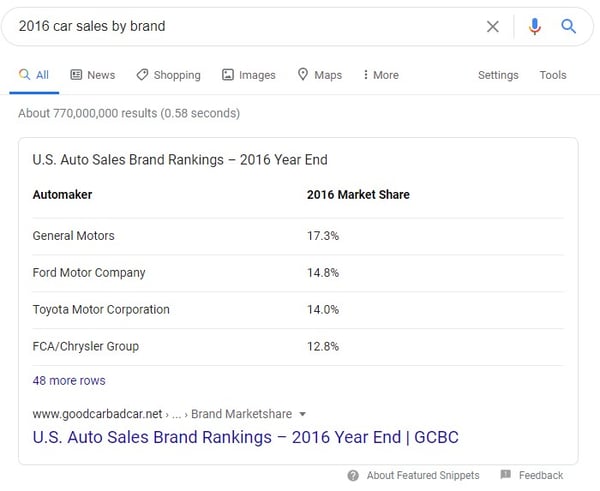
Video
Video result embedded on the page intended to answer the searcher's query in a visual/auditory format.
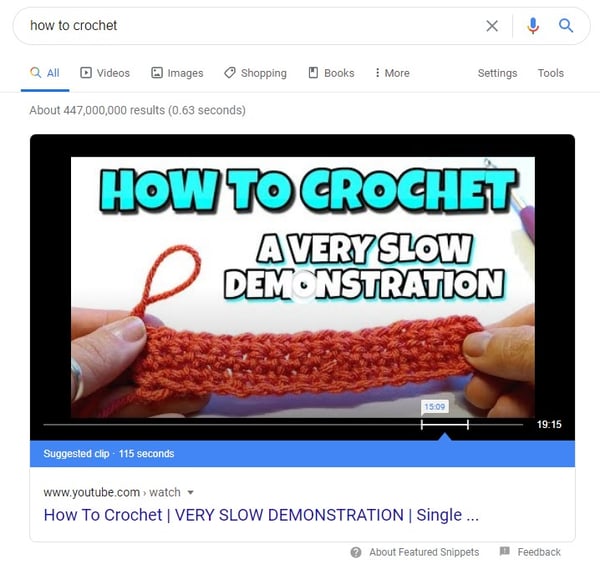
Accordion
Answer to the searcher's query presented with additional information that the searcher can choose to expand to learn more about.
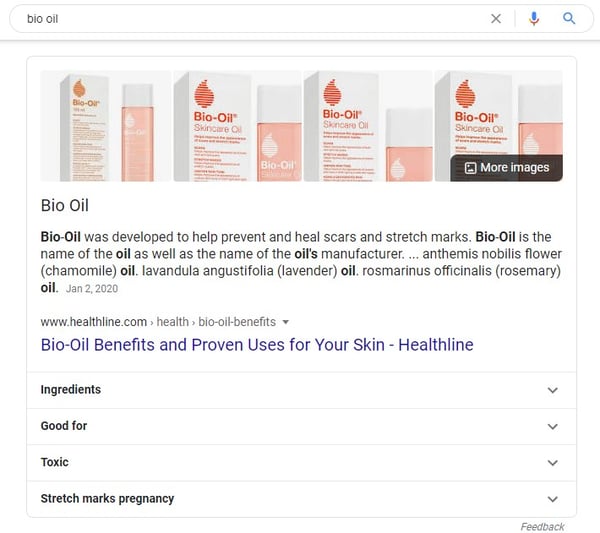
Rich Answer
Short call-out in which the answer to the searcher's query is featured in bold along with additional information.
These often manifest for questions that have factual, metric-based answers:
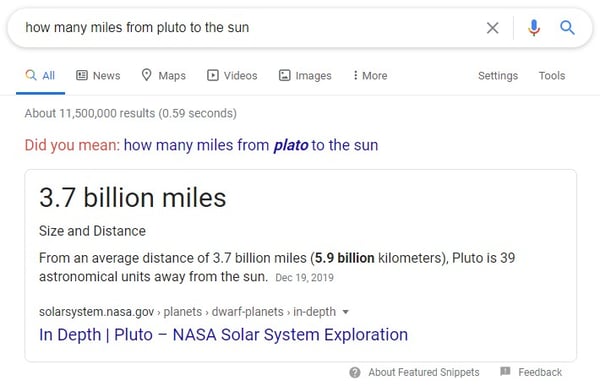
In addition, dictionary definitions are common rich answers:
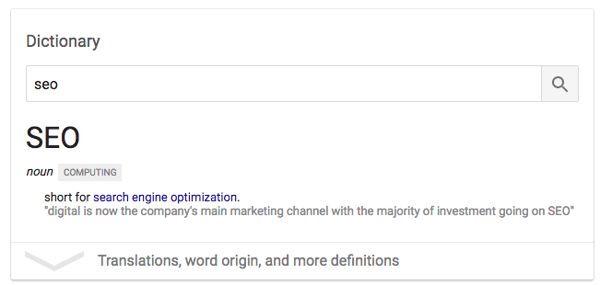
Tool or Calculator
Answer to the searcher's query in the form of an interactive tool that can output user-specific answers.
Tools can appear for very high-level and concrete queries. Examples of tools that Google shows are calculators, conversions, time zones, weather, game scores, and more.
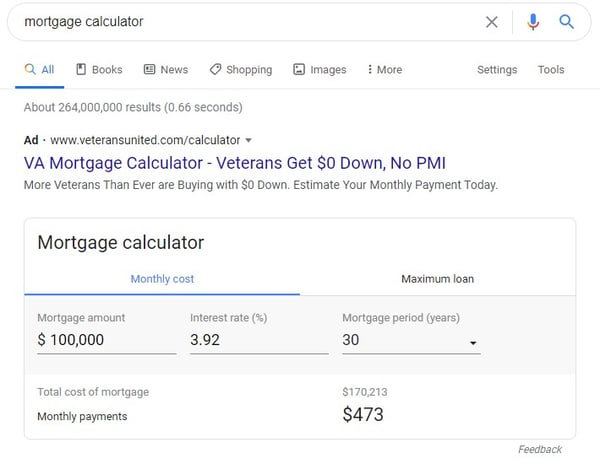
Why Should You Care About Featured Snippets?
One of the first conclusions that a lot of people involved with SEO jumped to was that Featured Snippets would have a hugely negative impact on the amount of people that actually click through to the pages within the results. This actually hasn't been the case. In fact, it's dramatically increased the click-through rate (CTR) of results ranking within it.
From a sample of just under 5,000 queries, I found that the CTR to the HubSpot website for high volume keywords increased by over 114%, even when we ranked #1 (just below the Featured Snippet -- like in the example below).
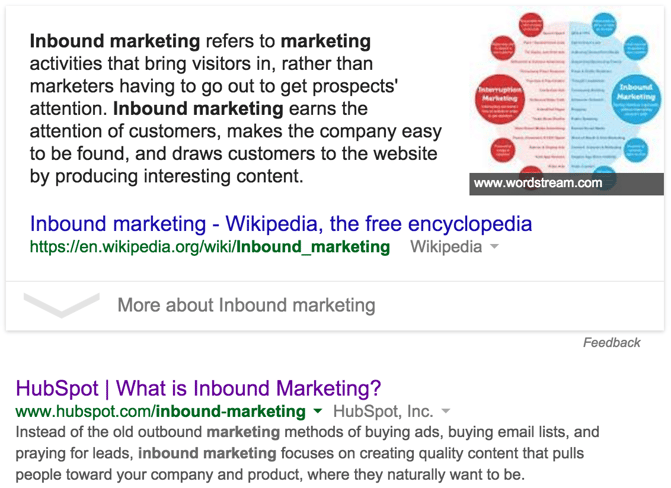
So to give you an example, let's say you rank #1 (the first post below the snippet) on page one of Google for a keyword that's searched for 10,000 times. From the data I've collected, you could expect roughly 1,700 visits, compared to the 3,700 you might see if you landed the Featured Snippet spot -- and that's just one keyword.
Here's another interesting piece of data that illustrates how valuable it can be to rank in the Featured Snippet within Google:
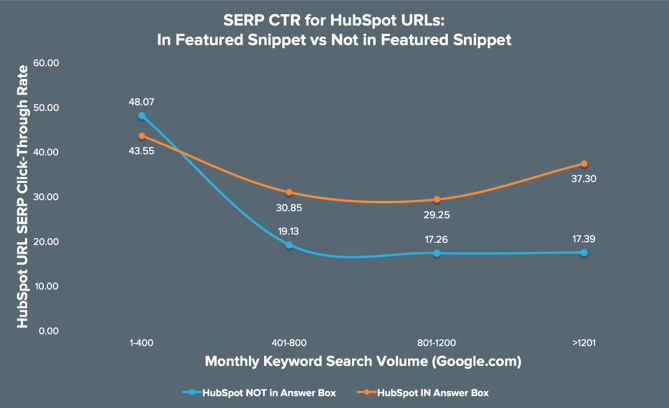
Again, to decipher this graph, here's a brief overview:
- The x-axis relates to the monthly search volume for the search queries measured.
- The y-axis shows the click-through rate (CTR) of the ranking HubSpot URL from within Google (i.e. how many people clicked on our search result versus the rest of the results in the search results page for a query).
- The blue line plots the CTR from the SERPs for HubSpot URLs when we do not appear in the Featured Snippet, broken down by query search volume (x-axis).
- The orange line plots the CTR from the SERPs for HubSpot URLs when we do appear in the Featured Snippet, broken down by query search volume (x-axis).
By and large, we get much more clicks through to our content when we appear in the Featured Snippet, but this becomes increasingly important as the search volume for a query increases.
For high traffic keywords, ranking in the Featured Snippet saw an average increase in CTR of over 114%, and that's even if we're ranking #1 on page one.
Now that you know that featured snippet acquisition is a worthwhile SEO strategy, there are a few things that you should keep in mind as you attempt to win your own placements.
How to Get a Featured Snippet
- Target question-based queries.
- You don't necessarily need to use schema.
- Organize the structure of your pages with headings and paragraph tags.
- For non question-based keywords, take a definition-style approach.
- When applicable, include steps for solving a problem or answering the question.
- The content should be between 54-48 words long.
- Don't rule out an international approach.
- Don't worry about backlinks as much for Featured Snippets.
If you're looking to learn more about how to optimize your content for Featured Snippets, HubSpot Research has a full research report: HubSpot's Guide to Winning Google's Featured Snippet and HubSpot Academy has a free SEO course.
Featured Snippets have been a bit of a mystery for a lot of people involved with SEO, as it hasn't been that easy to determine what influences getting your content to appear within them. Here's what we know for sure:
1. Target question-based queries.
Stone Temple found that from 850,000 question-based queries, 19% of them had a Featured Snippet.
2. You don't necessarily need to use schema.
There's been a lot of conflicting advice out there about markup for snippets, including the idea that Schema.org data was the reason behind Google displaying this data. However, considering that more than 80% of the websites I've looked at that rank within the Featured Snippet don't use any kind of Schema.org markup data, it's safe to say that this isn't the case.
Not only that but Gary Illyes, a Webmaster Trends Analyst at Google, has said outright that structured data has nothing to do with ranking in the Featured Snippet.
3. Organize the structure of your pages with headings and paragraph tags.
Markup aside, a clear page structure seems to be important as well as the semantic relevance to the keyword in question.
There should be an area on the page where the search query appears in a header (h2, h3, h4, etc.). The content you want to appear in the Featured Snippet should be placed in a <p> tag directly below the header.
4. For non question-based keywords, take a definition-style approach.
For shorter, less question-orientated keywords that display a Featured Snippet (e.g. "Inbound Sales"), it's much more likely that Google will pull through a paragraph of text. Google tends to prefer 'answers' that begin logically as an answer would.
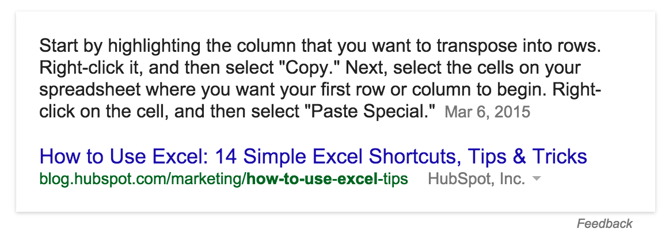
5. When applicable, include steps for solving a problem or answering the question.
Some answers require a more in-depth explanation, often involving a step-by-step process. Page structure is incredibly important here. Each step should be structured appropriately in a list format or represented on the page as heading (h3) tags.
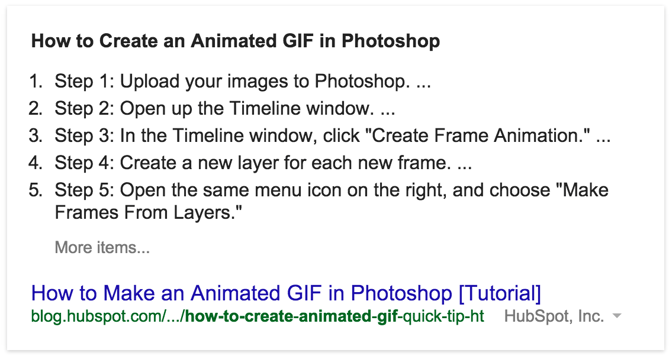
6. The content should be between 54-58 words long.
For the paragraph-style answers (not the steps), content that's between 54-58 words long tends to perform the best.
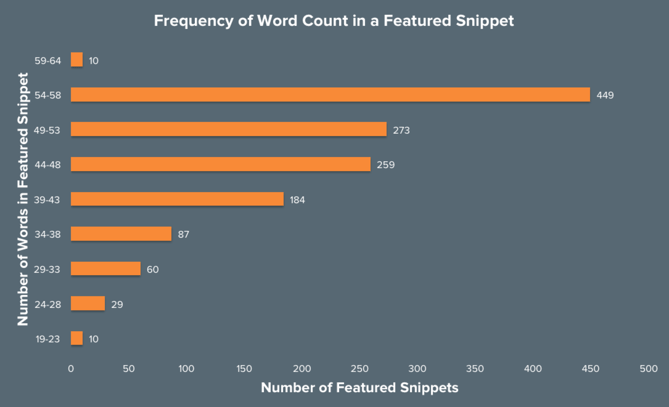
I extracted all of the content from within the Featured Snippets that I sampled. I did this to identify any trends in the content being displayed in order to better understand what Google is looking for.
As you can see, content between the length of 54-58 words in total seemed to appear by far the most frequently.
7. Don't rule out an international approach.
Featured Snippets for the same query often have different content within Google.com, Google.co.uk, Google.com.au, and Google.ie. Try "how to search on Google" as one of many examples.8. Don't worry about backlinks as much for Featured Snippets.
During my analysis of 4,713 HubSpot queries for Featured Snippets, I uncovered something unusual, shown in the chart below.
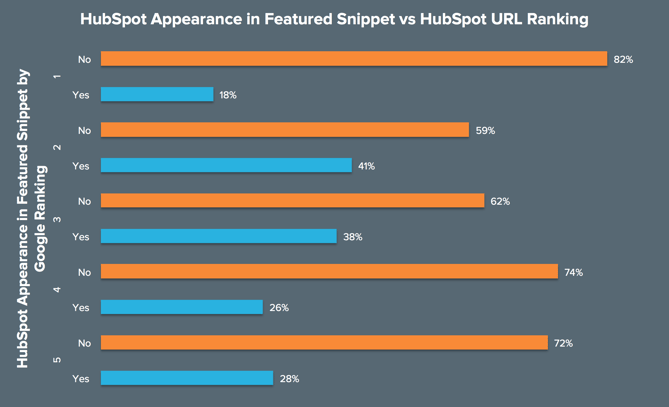
Allow me to explain what this chart is demonstrating:
- The numbers (1–5) in the y-axis relate to the position on page one that a HubSpot URL ranks for a given query.
- For each position HubSpot ranks for, there is a bar that shows how often we appear in the Featured Snippet (blue) and how often we don't (orange).
So, for keywords that we rank #1 for on page one in Google SERPs, we only appear in the Featured Snippet 18% of the time. Contrastingly, we appear in the Featured Snippet 28% of the time when we rank #5. Strange, right?
Well, what this says to us is that once you're in the top 5 results on page one, building backlinks and other authority signals matter much less for ranking in the Featured Snippet.
In fact, I've seen lots of occasions where relatively unknown websites with much less SEO authority than HubSpot have ranked above us, possibly due to more intentional use of page structure and other best practices described above.
My advice for anyone looking to increase their visibility within the Featured Snippet box is to first run a quick audit of the keywords that you're ranking for within your current SEO campaign and how many of them are question-based queries. Once you've got this list, you can drill down on where you're currently ranking, how well your content is structured, and then devise a plan to reoptimize your content based on the advice I've given above.
Editor's note: This post was originally published in July 2020 and has been updated for comprehensiveness.
from Marketing https://ift.tt/1tsWVv9
via
No comments:
Post a Comment